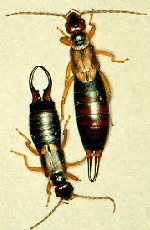
Consulting Entomologist

Tel/Fax: 01275 854224
E-Mail: [email protected]
Site Guide
Site Search
Home Page
Career Page
Insect Files
- Contents
- Bug Index
- The World of Bugs
- Classification of Bugs
- Insect Identification
- Insect Fossils
- Insect Body-parts
- Micro View of Bugs
- Insect Life Cycles
- Insect Defences
- Insects of Nailsea
- Pesticide Safety
- Bibliography
Shortcut to the main groups of insects and other arthropods...
Bug Rhymes & Poems
Links
Shop
Payments (credit/debit card)
Order Dermaptera - Earwigs(Derma-ptera, from Greek derma = skin, pteron = wing) |
Class: Insecta Order: Dermaptera | |
| Examples: | ||
|
Elongate insects with biting mouthparts and long, slender antenae. Forewings modified into short, leathery 'wing-cases' (elytra) which meet in the mid-line and reach only a short way down the body. The large, membranous hindwings are semi-circular with radial veins and when not in use they are folded in a complex manner under the small front wings, although many species are entirely wingless. The cerci are modified into stout forceps or pincers at the end of the abdomen, more strongly curved in the male than in the female (see below). Metamorphosis is slight, normally with four nymphal stages. This is a small Order of about 1,000 species - only four of these are native to the British Isles. |
|
RELATED PAGES (Other Dermaptera) | ||||
|
INSECTS OF NAILSEA |
||||
|
(classification of insects) |
(identification key to insect orders) |
| <<< TOP | (use the back button on your web browser to return to the previous page) | TOP >>> |
